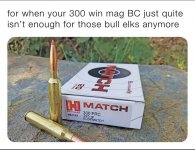I'm curious to hear if you have thoughts on something an outfitter could do/use as a baseline besides ft. lbs. if you're not a fan of that metric? I like it because it combines quite a few things and makes an easy button solution for an outfitter. To make it clear, I'm using Ft. Lbs minimums as something that could be used instead of an entire caliber restriction for an outfitter. I absolutely understand many things go into the ability to kill an animal beyond how much energy it has. I don't think however, that any other metric takes into account velocity and mass (ft lb metric), and sectional density, and ballistic coefficient (to get your velocity metric to apply to ft lbs). I look at it like pulling a Density Altitude reading vs pulling station pressure AND elevation.
In my eyes, the benefit of ft. lbs. over a velocity window as you mentioned is the velocity is already taken into account along with bullet efficiency with the solution for ft. lbs. I understand and acknowledge manufactures test at velocities to provide maximum and minimums for proper bullet expansion as they design and test it. But those velocity ranges transfer easily to ft. lbs. A manufacturer says 1600 fps minimum for bullet x, well it's extremely likely a ft. lb. minimum ensures the client is above that velocity as long as they choose the right energy minimum (1500 in this case). I’m sure I could find an example that doesn’t fit, but the majority of bullet minimum velocities are in that 1500 ft. Lbs. range. It also takes into account the bullet efficiency/density and weight obviously. The less efficient a bullet, the less ft. lbs. it will have the further out it goes because it bleeds off velocity faster due to the inefficient design. My issue with a velocity minimum is a person could load up a light bullet in a large caliber and send it screaming. It may be a fantastic choice for lots of hunts and it may not be for some hunts. Again, those light bullets bleed off energy fast. If an outfitter wanted to utilize velocity to weed out what they determine not enough power for the game being chased, are they going to look at each bullet manufacturer and make a list of minimum velocity numbers? That seems like a lot of work. Ft. Lbs. seems like the easy button to me to take into consideration their bullet efficiency getting to that yardage and how much velocity it's already shed, and energy at the time of impact in at said yardage with that current velocity. While a ft. lb. minimum wouldn't fit within a manufacturers velocity window 100% of the time, it would say 95% of the time. What it doesn’t take into account is the type of bullet as mentioned earlier, so whether the design is to pedal, mushroom, fragment, etc...
I think there needs to be a solution rather than to just restrict an entire caliber. Maybe it’s as simple as restrict specific cartridges instead. I'm happy to hear any. But, as I said in the first sentence, a business owner can and should have the ability to set up his business anyway they wish so I guess this is really a moot point and scotchy scotch scotch.

